Rewind to 1980: England U17 Cadet Team US Tour Report

After publishing my report on the 10 Days in the States with Barking Abbey, a number of people got in touch, including legend of the game, Humphrey Long.
Long was the coach of the England Under-17 Cadet team back in 1980 (as well as at the helm of then-powerhouse East London Royals), and had taken the side to the US for a tour of their own, facing local high school teams in California. He had written a report of the trip, and asked whether I would be interested in taking a look; I, of course, said yes and he sent it to me through the post.
It made a fascinating read, with very similar observations made to my own – I asked Humph if he would be happy for me to share on Hoopsfix for everyone else to read, and he obliged. We spent some time typing it all up, and below is the end result (including his accompanying letter – everything is copied word for word, unedited); take a look and let me know what you think – it is a small piece of English basketball history that should be preserved!
Without further ado, over to Humph:
Hi there Sam,
Further to our recent Facebook conversation I am enclosing an account of a basketball trip to California in December 1980. This was by the England Under 17 Cadet team. It was originally planned that the Under 19 Junior Men would go but they had other plans for their budget.
Each member of the group had to contribute £300 towards the costs of the trip that lasted for two weeks. As it turned out it would have been preferable for the 19’s to have gone from a purely competitive point of view because of the disparity of age with our opponents. But we did have a great time. As well as playing the games we did watch a couple of college games, also the Lakers and a visit to DisneyLand.
The following year we did play host in East London to an Orange Country High School all-star team and even arranged for them to travel to France.
In October we had a trial to pick the squad but did not meet again until arriving at the departure lounge at Heathrow at the end of November. The boys and coaches had never met until then. Not a good preparation. You may notice in the squad Paul James and Robbie Peers – the former a present BBL coache and the other that also coached the BBL.
If I had been more aware of the Barking Abbey trip I would have sent this report for them to be aware of some of the problems that we encountered. I am sending it to them now so that we can compare experiences.
Their report made fascinating reading and I am impressed the way they managed to pick themselves up after some initial disappointment and hold their own down the stretch. We did have a major problem with the different rules and the intransigent referees applying them. No one over there seemed to have any idea that rules were different outside of the States.
I sent my report to as many as people as I could that I thought might be interested in our experience. Did not get much of a reaction except from one coach in the north that thought it was a total waste of money.
Hope you find it of interest. I also have my report from earlier in 1980 of the only ‘draw’ in international basketball history. I will send it when I find it. I will also let you know when I have completed my History of Junior Basketball. Up to 2006 at the moment – just 7 years to go. Should take another week or so.
All the best.
Humph
An American Journey.
The story of the Boy’s Under 17 Cadet Team
Visit to Southern California
29th Nov – 13th Dec. 1980
Results.
England Under-17 42 Huntington Beach High School 79
England Under-17 35 University High School 68
England Under-17 45 California High School 53
England Under-17 49 Los Amigos High School 52
England Under-17 46 Santiago High School 63Touring Party: John Lloyd (Head of Delegation), Alan Thompson (Team Manager), Humphrey Long & Rick Wooldridge (Coaches), Paul Guinan, Paul Connery & Paul Ogden (Oldham), Simon Bell (Leeds) , Paul James (Leicester), Andy Maher (Coventry), Andy Bayles (Gravesend), Chris Ling (Felixstowe), Keith Davies (Hemel Hempstead), Tom Woodcock (Bolton), Robert Peers (Ellemere Port) and Graeme Herron (Sunderland).
On first looking at the results listed above it does not appear that this visit to America was very successful. In terms of results this was true but we did not go expecting to win only to learn by experiencing a level of basketball we were unlikely to encounter anywhere else in the world.
Yet when put into perspective even the results can be partially accounted for as we were much younger side than the teams we met – 15/16 year old against 17/18 – and we had never played a match as a team before whereas the Americans had been together for up to three years and had been training for two hours a day since the middle of October.
Finally we found the difference in rules most disconcerting early on and the time difference could not be completely discounted, our first game was played at what would have been 3:30 in the morning back in England. Another problem we encounter was that the hosting arrangements meant that the players and coaches were accommodated thirty miles apart during the first week and without personal transport it was impossible for players and coaches to get together except for games. So there were no training sessions until after the third game.
Things improved during the second week when American coaches lent us their cars and we were able to move around in greater freedom and meet up for two training seasons. To be without a car in California is like being on a desert island without a boat. This kindness of the American coaches lending us their cars was typical of the hospitality shown us over there. Nothing was too much trouble for them. They took us into their homes – sometimes moving their own children out to friends or neighbours – treated us as their own family and steadfastly refused any payments for food, phone calls home or taking us to shops or to places of interest.
We made so many friends on this trip that the basketball was virtually pushed into the background we were all entertained to what could only be called the trip of a lifetime.
But there was a great deal of basketball as we learned just how big a part it plays in the American sporting culture with lots of outdoor courts, hoops on garage roofs, courts on the pavement by the beach and plenty to watch on television. The indoor facilities of each high school we visited were also most impressive. They all had beautiful courts with ample spectator accommodation in the form of retractable bleacher seating with electronic scoreboards at both ends.
Huntington Beach had three full sized courts side by side which could be separated by partitions at the press of a button. All the schools have quite huge populations with anything up to 5000 pupils between 15 and 18 so they do need ample facilities. They seemed to have a system whereby there was general games and physical education in morning school between 8:00 and 2:00 and then specific team trainings in the afternoon when the other children went home.
Each team in a school – freshmen, junior varsity and senior varsity – would train for two hours each afternoon and have a separate coach plus its own back-up team of managers, scorekeepers and cheer-leaders. We played all our games against the senior varsity team so we met the best players in school, although it must be said that by the American standards these were only average high schools with no prospective all-Americans on their teams.
They had no idea when arranging this tour just what our standard would be like and they were under illusion that as we were a national side we would be too strong for them.
On reflection by both them and us it would have been better had we had a couple of settling-in games against junior varsity teams which are like reserve teams for the senior varsity and generally contain younger players. This would have enabled us to acclimatise ourselves to the rules and get ourselves organised offensively and defensively for the tougher games.
We did not really know our players own strength and weaknesses and because all the ensuing games were so tough the weaker players often pitched into the deep end – often with traumatic results.
We obviously learned a great deal about the ability of several of our players on this tour and there were some that impressed with their determination to fight through in adverse conditions and there were those, unfortunately, who either succumbed to the pressure or just did not have sufficient skill to cope with it and wilted.
All of these players had never been subjected to the test of performing under such pressurized conditions before. The character of individual players and the team as a whole was put to the test against fundamentally sound teams, talented individual players, a strange environment, vociferous and partisan crowds, noisy bands, attractive cheerleaders and the unsettling effect of different rules.
On the day before our first game we received a copy of the rules pertaining to high school basketball – which are different from college, professional and international basketball rules. A cursory glance at the rules told us little although we realised that the ball is put in from the end–line by both the offence and defense rather than being taken out at the side as in international rules.
We realised we had to work out some in-bounds plays to use at both ends of the court because of this situation and also to defend against in-bounds plays at our defensive end. We also noticed that we could have five time–outs in the game and could carry forward any not used in any quarter.
The games were to be in four quarters of eight minutes each so effectively with the breaks at the end of each quarter a team could have eight time–out situations. But of course reading the rules and playing under them are two different things.
We soon discovered in the first game against Huntington Beach, which was the best team we met anyway, that there were many more problems for us. The fact that the referee has to touch the ball on all out of bounds situations – and not just touch but hold it away from the player putting it in – meant that we could never get the ball quickly to beat the inevitable press.
After six team fouls there was a bonus situation but a ‘one and one’ was given which meant that a player had to score the first shot to get the second and the ball was live on the first shot if missed so everyone rushed in for the possible rebound. The Americans were used to this rule obviously and charged in on the first shot at either end.
Their players were excellent free-throw shooters and rarely missed the first shot unlike ours who wasted many bonus situations. It is certain that we could have won the second and third games we played if we had scored a few more of our free–shots.
The American players were very physical and their coaches were saying that this is the way the game has gone over there. The rough type of game is now the norm and we never saw a ‘deliberate’ foul called once although there were, in our opinion, several fouls which warranted this description.
Being younger and physically out-matched anyway we never did get used to this rougher interpretation of the game. In fact the referees were often harder on our physical indiscretions than our opponents’ and, apart from one notable exception, were not very sympathetic to our ignorance of their rule differences. This was especially true with regard to the request for time-outs which, over there, must be asked for by a player on court. Of course this is to change the habits of a life time for English coach and player and we had great difficulty getting time-outs in the first two games although we perfected a system after that.
But the first two games were our heaviest defeats and it was in these that our problems were greatest. With a little more understanding from intransigent referees we would have managed to cope but they also did not appreciate that international rules were so different.
The ‘back-court’ rule also gave us some difficulty as the Americans allow the ball to be passed directly from out of bounds in the front court into the back court. Also the team must be in control of the ball to be liable to violate the rule. So deflections into the back-court and stumbling into the back court with the ball were all permitted. We never did see a consistent interpretation of this rule although we generally appreciated the spirit of the American interpretation of what is and what is not a back-court violation.
We also appreciated the way in which their substitutes run on and off the court with little or no recourse to and official’s permission as long as the sub has reported to the table – this really speeds things up. The technical set-up in which only the player taking the shots is in that half of the court was something we had never seen before and we did not think we cared much it. But it appears that the ball is never live after shots for a technical foul.
Finally there is not 30 second clock in American basketball but the games that we played in were not subjected to any stall situations. The players seemed to look for the first opportunity to shoot just as in our basketball. We did discover, however, that you can have a ‘five-second’ call while dribbling the ball. It seems you have to pass the ball against a tight defense or you are penalised. This is probably a result of the no–thirty second clock and avoids long stall dribbles.
The American set-up for basketball is very interesting. The various sports are allocated a season and are not allowed to overlap. So no team basketball training is allowed before the middle of October and no games may be played before the 1st of December. This is so as not to interfere with the American football season which runs from September to December.
The basketball season begins with tournament play with many schools organising tournaments like the one we were in at Laguna Beach High School. Between the end of the tournament and the beginning of January a school will play ‘friendly’ games against teams it does not meet in its league schedule. This enables the coach to see between five and ten non–league games to get his team organised for the ‘real’ games.
In January the league programme starts and the league will usually consist of about eight or ten teams. Each team is met home and away so between sixteen and eighteen league games are played at a rate of two a week. The league games are usually preceded by a J.V. or freshman (first year or our 4th Year) team. This enables younger players to get used to the big–time atmosphere always part and parcel of America’s high school basketball.
At the end of the season in late February there come the inter–league play–offs to decide county or State champions. While we were in California the Orange County Football play–off final was being held and about thirty thousand people went to see two high schools decide the championship. So each high school will have about 25 – 30 games in its season and the coach is very jealous of his won/lost record because he is paid extra money for taking the team and there are others willing to take the job if his record is not good enough.
There is also a lot of status for players to be ‘on’ the varsity team because it means high standing in the school and the local community. The better players get regular attention from the press and even on television. There is also the prospect of a college scholarship for outstanding players and a college coaching job for successful coaches. It is a vast breeding ground for basketball talent but to achieve the level of excellence it is highly selective and players know that unless they are good enough to play in college their varsity season is likely to be the last year they will ever play basketball seriously again.
There are some recreative programs and some inter–mural college basketball but there is no club structure on the European pattern. Some American coaches were envious of our unpressurised system of sport and education and did not like the way their schools have become the training ground for professional sport.
Tactically we saw and met a great deal of full–court pressure. We did see some man for man pressure by one team but mostly it was full or half-court pressure. The American rules help the press to set up while the referee is handing the ball and we did not handle the press well in our first two games as our big men went away and did not break back to the ball. We were inclined to panic early on but we did get better during the tour.
The last game saw us meet pressure and traps at mid–court and this caused us to have one disastrous quarter. They dropped back almost exclusively into 2:1:2 or 2:3 zones. We met a lot of zones and had little opportunity to try out our man for man offense. The zone defenders worked very hard and were very tough inside, especially on the boards. We worked well against the zones but either rushed our shots or did not take the ‘open’ shot when it was there.
Unlike the Americans we are not endowed with lots of good outside shooters and we do not have their confidence. As can be seen from the scores we did not shoot well and we did miss a large number of easy shots. Conversely the standard of American shooting was consistently high. They finished the break well, shot well from the outside and good inside moves for their big men.
They had a high standard of guard–play and the fundamental skill which impressed us most was the passing of all players especially the penetrating passing of the guards. Rarely was it flashy but fast, crisp and accurate. The speed of all players getting down the floor was most impressive.
Once the ball was secured from a rebound, steal or violation the players just took off for the other end. The ball would be whipped down–court with a quick dribble and pass or one huge court–length pass which was usually right on the button. All teams employed a fast break of some sort with more structured or organised more than others. All teams were well organised on their set offences and the players obviously knew what they were doing.
We had hoped to see some of the passing–game offenses which are so popular in the States but with so many zones being played the zone offenses were mainly in evidence.
Overall there was a level of individual and team skill which we could not hope to match. At times we played well but we were never comfortable enough to be able to relax and play a high–level game instinctively like they can.
We know what we have to do to get better but will we ever have the facilities, the time, the coaches and the tradition to match them? It is very doubtful as we are only just beginning to match the Europeans and they must be our first yardstick.





6 Comments